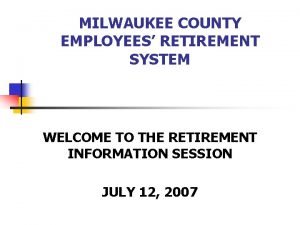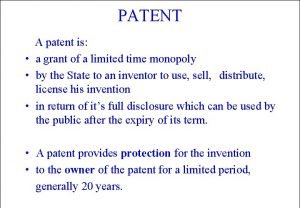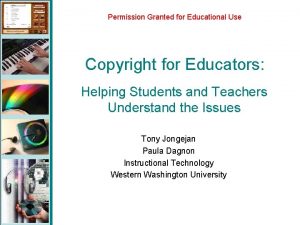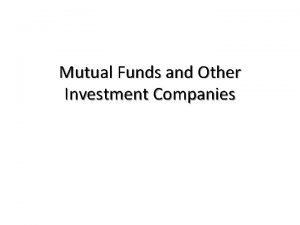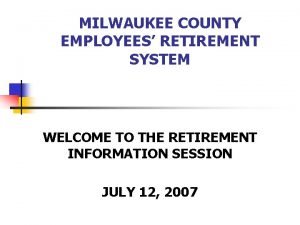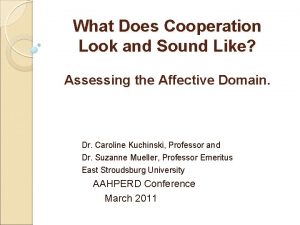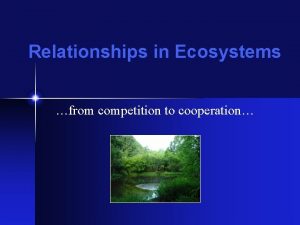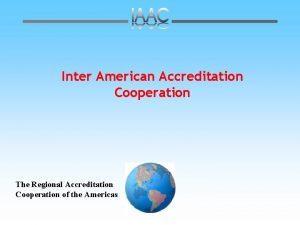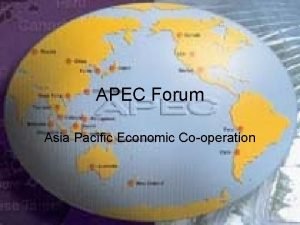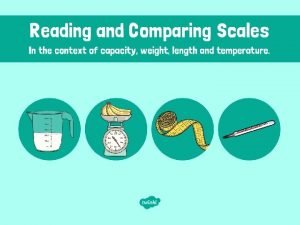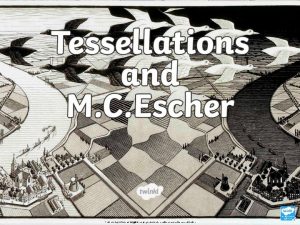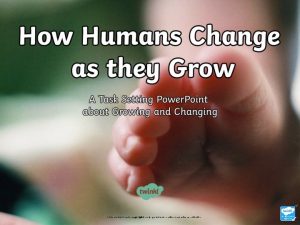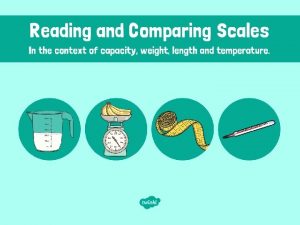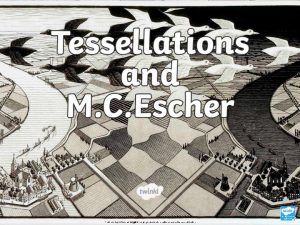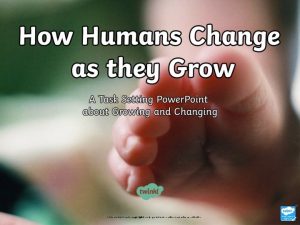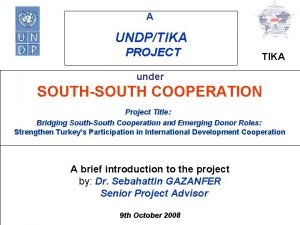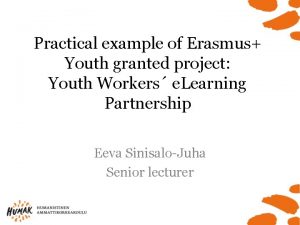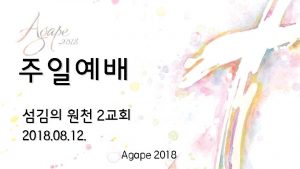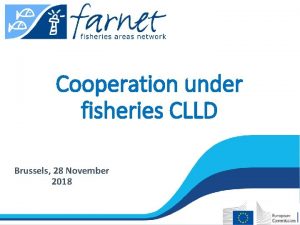8 March 2018 PROJECT GRANTED UNDER INDOEUROPEAN COOPERATION





















- Slides: 21

8 March 2018 PROJECT GRANTED UNDER INDO-EUROPEAN COOPERATION ON RENEWABLE ENERGY

Offshore Wind Grid Integration Assessment for GJ & TN Policy and Industry Background Onshore Grid Development Offshore Grid Development (scope) System Operation Technical and Regulatory Codes 2

STAKEHOLDERS IN THE POWER SECTOR 3

ONSHORE GRID DEVELOPMENT • This section examines the key delivery risks of offshore wind development with respect to the current onshore grid planning and development • Assessment based on: – Review of inter-state and intra-state transmission planning process – National Electricity Plan (Generation & Transmission), 2016 – Development of ‘Green Energy Corridors’ in Gujarat and Tamil Nadu – Intra-state grid developments in Gujarat and Tamil Nadu – Grid impact studies conducted by GETCO and TANGEDCO 4

ONSHORE GRID DEVELOPMENT Integration of 500 MW OWF to Gujarat Transmission System § System study for 500 MW OWF at Pipavav at 400 k. V level by 2020 § Observations: o No system violations observed in load flow and contingency power flows in peak loading conditions o System violations observed in load flow and contingency power flows in off-peak loading conditions o Fault current levels are within the allowed short-circuit ratings § OWF curtailment might be necessary during off-peak 5

ONSHORE GRID DEVELOPMENT Integration of 500 MW OWF to Tamil Nadu Transmission System § System study for 500 MW OWF at 400 k. V level in Samugarengapuram S/S by 2021 -22 § Observations: o Load flow, contingency analysis, and short-circuit analysis show no system violations § The study considers several network development cases in a timely fashion and impacts of delay or non-delivery of any of the cases could undermine the feasibility of power evacuation 6

ONSHORE GRID DEVELOPMENT Based on the assessment of the challenges and risks for onshore grid development, broad areas of recommendation are made below: Barrier Mitigation Offshore wind not included Formulate state and national targets for in current grid planning offshore wind scenarios Include offshore wind development scenarios in long term planning Delayed delivery of necessary onshore grid reinforcements causing power export constraints Prioritise anticipatory investment in grid expansion (e. g. Green Energy Corridors) Key Stakeholders MNRE, Mo. P CEA, CTU and STUs 7

OFFSHORE GRID DEVELOPMENT • This section examines the offshore power system, and its key components, their characteristics and potential configurations. • Assessment based on international standards, best practices and lessons learnt from mature offshore wind markets. 8

OFFSHORE GRID DEVELOPMENT Key Design Considerations • Technical Limitations of Assets: e. g. continuous current rating (installation dependent), voltage operating range, fault levels etc. • Compliance: With local codes, standards and regulations. • Electrical Losses: Typically in the range 2 -5% depending upon the export voltage and distance offshore. Valuation depends upon location of the metering and the allocation of transmission losses to different parties. • System redundancy and Resilience: Due to the elevated capital costs, offshore transmission systems are generally not designed fully (n-1) redundant, therefore the risk exposure to single points-of-failure (e. g. submarine transmission cables) must be carefully considered and mitigated in design and specification. Typical Electrical Concept Design Development Process 9

OFFSHORE GRID DEVELOPMENT Offshore grid systems are very similar to traditional onshore grid systems, but there are subtle differences in the nature of components and their ratings and application. At present, there is limited experience in India for the planning, design and construction of offshore transmission systems. Recommendations 1. Short term: International consultants may fill the competence gap 2. Long term: Develop a roadmap for development of local resource pool 10

OFFSHORE GRID DEVELOPMENT • When developing an offshore transmission system one must consider the topology of the offshore grid such that grid connections can be developed economically, in an incremental fashion, with due regard for ‘future proofing’ of the transmission system. • Three connection topologies are discussed in the report, together with a case study for each. – Radial: Each individual offshore wind farm connects to the onshore transmission via its own dedicated transmission link. – Clustering: Multiple wind farms are located geographically close enough to share transmission infrastructure – Integrated/Meshed: This concept has multiple offshore interconnections between projects with a diversity of onshore connection points. Characteristics closely resemble onshore grid topology. The first offshore wind projects in India are likely to use a radial grid topology, but a clustering or integrated approach might be more suited for future developments. 11

OFFSHORE GRID DEVELOPMENT Three regulatory models of offshore grid delivery and ownership are compared. Model Features Key benefit Countries Generator model The developer is responsible for the construction of the offshore grid connection and bears its entire cost High incentive to implement a cost-efficient connection and ensures coordinated development of wind farm and offshore grid Sweden TSO model The transmission system operator (TSO) is responsible for extending the grid to reach the wind farm Allows for coordinated long term Germany, planning of offshore grid France, expansion Netherlands Third party model A tender is run to appoint a third Allows for competition and UK party as the Offshore companies to specialise in their Transmission Owner (OFTO) to operations build, own and operate the connection asset between the wind farm and the onshore transmission network Each model has its advantages and disadvantages. The choice of model determines the cost and risks borne by the various stakeholders, and so it is important to have a clear policy in place. 12

OFFSHORE GRID DEVELOPMENT Based on the assessment of the challenges and risks for offshore grid development, three broad areas of recommendation are made. Barrier Mitigation Key Stakeholders No policy exists for delivery and ownership of offshore transmission systems. Select either generator built or TSO built CEA, CTU, STUs model for ownership of the first offshore wind projects Mo. P, MNRE, CEA Initiate a Central Working Group to frame an enduring national offshore transmission policy No framework exists for Initiate a Working Group to evaluate the CEA, CTU, STUs offshore transmission network optimal transmission topology and system planning regime for Gujarat and Tamil Nadu. There is limited experience in International consultants may fill the gap in India for the planning, design the short term. and construction of offshore A longer term roadmap for development of transmission systems. local competencies should be devised. CTU, STUs 13

SYSTEM OPERATION § The objective of this section is to understand the current challenges in system operation with renewables and their implications on development and operation of offshore wind sector. § Approach: o Review of current operational issues at National level. o Review of specific system operational issues in Gujarat and Tamil Nadu. o Implications on development of OWF in Gujarat and Tamil Nadu. 14

SYSTEM OPERATION • RES are different from the conventional generators in various operational aspects: o Generation variability and intermittency o Forecasting errors o Lack of contribution to system inertia § OWF are slightly different from onshore wind and solar PV o o o Larger size Higher capacity factor in operation Better accuracy in generation forecasting Better reactive power control Better support to system ancillary services § OWF can positively affect the system operation 15

SYSTEM OPEARATION Three key recommendations are drawn on system operational aspects Key Stakeholders Barrier Mitigation Incomplete/delayed enforcement of national action plan for facilitating large scale renewable integration Uncertainty around the absolute level of grid curtailment at present and expected in the near future Rigorous follow-up and timely enforcement of identified mitigation measures NLDC, RLDC, CTU Measure, report and set targets on curtailment levels CERC, RLDCs, SERCs, SLDCs Limited experience in system operation with increased penetration of RES Review the international practices and NLDC, RLDCs, implement knowledge exchange/ capacity SLDCs building programs to fulfil the gaps in the short term Long term roadmap for development of local competencies 16

TECHNICAL AND REGULATORY CODES § This section examines the key codes and processes which are crucial to the development of offshore wind farm § Three documents are reviewed: o Connection application process o Grid code o System reliability standards 17

TECHNICAL AND REGULATORY CODES Three recommendations are drawn after the review of existing technical and regulatory codes and their suitability for offshore wind projects Key Barrier Mitigation Stakeholders The connection process does not specifically address offshore wind projects. Grid codes do not specifically address specific characteristics of offshore wind and its transmission connection Planning standards do not Publish guidance on connection application process for the first offshore windfarms. CTU, STUs, CERC, SERCs Future code modifications should be reviewed considering the specific characteristics and quantum of power from offshore wind farms. CEA, CTU, STUs, CERC, SERCs Review the need for a separate grid code or modifications specifically for offshore wind projects. Clarify on the compliance boundary of OWF under individual grid code requirements Clarify on the applicability of present 18 CEA, CTU, STUs

CONCLUSION Four overarching themes are identified in the report Delivery of existing RES action points § To facilitate the grid integration of offshore wind § To reduce delivery and curtailment risks Offshore wind policy and code development § National and state level targets § Framework for delivery and ownership § Due considerations in technical and regulatory codes Grid development planning Inclusion of offshore wind in long term planning process Strategic grid development studies Competence and capacity building § Learning from international experience § International consultants for short-term capacity building § Local competence building plan for long-term capacity building 19

Q&A? Open Discussion 20

This project is co-funded by the European Union For more information please contact: FOWIND Project Management Unit, alok. kumar@dnvgl. com; shruti. shukla@gwec. net
 March march dabrowski
March march dabrowski Microsoft asp.net core privilege escalation (march 2018)
Microsoft asp.net core privilege escalation (march 2018) B a f c j e
B a f c j e Milwaukee county ers
Milwaukee county ers Positive reinforcement feedback
Positive reinforcement feedback Insecticide act
Insecticide act Permission granted to reproduce for classroom use
Permission granted to reproduce for classroom use Mutual fund returns may be granted pass-through status if
Mutual fund returns may be granted pass-through status if Milwaukee county retirements granted
Milwaukee county retirements granted Performance appraisal dpmap employee input examples
Performance appraisal dpmap employee input examples What does cooperation look like
What does cooperation look like Example of cooperation in social interaction
Example of cooperation in social interaction International laboratory accreditation
International laboratory accreditation European co-operation for accreditation
European co-operation for accreditation Cooperation relationship ecosystem
Cooperation relationship ecosystem Cooperation offer
Cooperation offer Interamerican accreditation cooperation
Interamerican accreditation cooperation Apec
Apec This type of work
This type of work Social interaction cooperation
Social interaction cooperation Pics scheme
Pics scheme Archi mate
Archi mate



